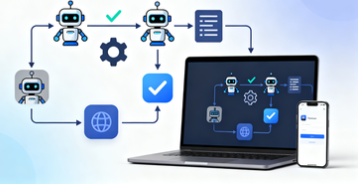It used to be that productivity meant working longer hours, pushing through fatigue, and multitasking our way through endless emails and to-do lists. But 2025 has made that definition obsolete. Productivity is no longer about doing more — it’s about doing the right things faster, smarter, and with less friction. Technology, once a distraction, has now become the most powerful ally for anyone trying to reclaim time and focus. Across offices, homes, and cafés around the world, a new generation of digital tools is quietly transforming how people work, collaborate, and think.

For many professionals, the moment this shift became real was the first time they used AI in their daily workflow. A London-based marketing consultant named Julia admitted that she once spent hours drafting client reports. Now, she opens her laptop, feeds campaign data into Notion AI, and in seconds gets a coherent summary that’s nearly publication-ready. What used to take her an afternoon now takes less than an hour, and she uses that saved time to actually analyze results or brainstorm new ideas. It’s not about replacing her expertise — it’s about multiplying it.
In 2025, tools powered by artificial intelligence are no longer luxuries; they’re the backbone of efficiency. From ChatGPT drafting proposals to Grammarly rewriting entire email sequences in natural tone, or Motion’s AI calendar automatically rearranging meetings based on real-time priorities, technology has evolved from a passive instrument to an active collaborator. People don’t just use apps anymore — they work with them.
Take a typical morning for someone like Kevin, a product manager in San Francisco. He starts his day by opening his personalized workspace on ClickUp, where an AI-generated dashboard shows him what needs attention first based on project deadlines and team activity. Instead of scrolling through messages or trying to remember what he promised last week, he sees a clean, dynamic map of his priorities. His email syncs directly with Slack, Jira, and Google Docs, so updates flow naturally between apps. When a designer in Berlin leaves a note on a prototype, he gets an instant summary written by the AI assistant, not just a notification. It reads: “The latest feedback suggests simplifying the navigation menu — potential timeline impact: +1 day.” No wasted clicks, no lost time. He smiles because productivity now feels effortless.
What makes 2025 remarkable is not the appearance of new tools, but how seamlessly they connect. For example, people have started linking automation platforms like Zapier or Make to manage the invisible, repetitive parts of their work. A small business owner can have every new client form automatically trigger a contract draft in Google Docs, log it in Notion, and send a Slack notification — all without lifting a finger. In earlier years, such setups required tech expertise. Now, these automations are created by simple natural language commands. You can literally type, “When I get a new client in Typeform, create a task in ClickUp and email them a welcome message,” and the system understands. That’s what “fast productivity” looks like — letting software handle what used to drain hours from human schedules.

At the same time, personal productivity apps have evolved into cognitive assistants. Tools like Mem and Reflect now use context-based reminders: instead of just telling you what’s due, they remind you why it matters. They track how you think and write, surfacing ideas you might have forgotten weeks ago. Imagine typing an article draft, and your app gently suggests: “You once noted an idea about digital minimalism — would you like to use it here?” It feels less like working with a machine and more like working with an attentive colleague who never forgets.
One of the biggest trends in 2025 is the rise of “invisible productivity.” The best tools are the ones you barely notice. For instance, email has long been a time sink, but tools like Superhuman and Hey have reinvented it. Superhuman filters, prioritizes, and predicts — it highlights messages you actually need to read, suggests replies, and even detects emotional tone, helping users send sharper and kinder responses. For busy professionals, this is not just convenience; it’s sanity restored. Instead of drowning in inbox clutter, they get to focus on meaningful communication.
Meetings, another notorious drain on time, are also being reimagined. A wave of new software — from Reclaim.ai to Fathom — automatically summarizes discussions, extracts action items, and updates project boards. Sarah, a startup founder in New York, says her weekly team meetings used to run for 90 minutes. Now they last 40, because everyone gets a pre-meeting summary generated by Otter.ai and an instant post-meeting recap created by the system. No one argues about “what was decided” anymore — the transcript does that for them. Technology has quietly turned chaos into clarity.
This fusion of automation and intelligence has expanded into creative work too. Designers rely on Figma’s AI features to generate wireframes from prompts. Writers use tools like Jasper or Copy.ai to brainstorm campaign ideas or rewrite paragraphs in different tones. Developers automate code snippets through GitHub Copilot, which predicts entire functions before they finish typing. A decade ago, this would have been considered cheating; today, it’s considered smart. The world is finally learning that creativity doesn’t disappear when machines help — it accelerates.
Yet what truly distinguishes the productivity revolution of 2025 is the personalization layer. Tools adapt to people’s natural rhythms rather than forcing people to adapt to rigid software. Calendars don’t just block time; they understand when you’re most alert. Motion, for instance, tracks when you typically complete tasks faster and schedules demanding work accordingly. RescueTime analyzes how you spend your digital hours and nudges you to take breaks before burnout hits. Some professionals even use wearable-integrated apps that monitor cognitive fatigue, suggesting when to step away or switch tasks. These tiny interventions can transform a workday — not by pushing harder, but by aligning effort with energy.
Remote teams have also discovered that productivity isn’t about being constantly online, but about being meaningfully connected. Tools like Loom and Asana now offer asynchronous updates — quick video messages or summarized progress notes that keep projects moving without endless meetings. A team spread across three continents can now feel cohesive because communication happens on their own time zones, with AI making sure everyone stays in the loop. It’s no longer necessary to chase time differences; the software bridges them.
Interestingly, 2025 has also seen a cultural correction. After years of chasing “hustle” culture, people are realizing that productivity without balance is meaningless. The best tools are those that create space for rest. Apps like Sunsama, which encourage users to plan only what’s realistic for the day, or Notion templates that include mindfulness check-ins, are becoming mainstream. Even corporate giants are catching on: Microsoft’s Viva suite now integrates wellbeing analytics, prompting employees to take reflection breaks. The goal isn’t to extract more labor — it’s to help people sustain high performance with lower stress.
For freelancers and entrepreneurs, this shift feels liberating. The tools that once required enterprise budgets are now accessible through affordable subscriptions. A solo content creator in Paris can run her business using Notion for project management, ChatGPT for content drafting, Canva for design, and Zapier for automation. She handles what used to be a full agency’s workload while still having time for afternoon walks. Her story isn’t exceptional — it’s the new normal.
But technology alone doesn’t make anyone productive. What matters is how these tools are woven into a personal or organizational system. Productivity still begins with clarity: knowing what actually deserves your time. The best users of tech in 2025 aren’t the ones who use every app, but the ones who combine a few in a thoughtful ecosystem. For instance, someone might use Todoist for daily focus, Notion for project tracking, and Google Workspace for collaboration — nothing fancy, just well integrated. The real trick lies in discipline, not in gadgets.
The paradox of the modern era is that with all these innovations, distraction is still a threat. Notifications, social feeds, and constant pings can undo even the best productivity setup. That’s why digital minimalism is becoming part of the conversation again. Professionals are learning to tame their tech rather than be ruled by it — muting irrelevant alerts, limiting app sprawl, and scheduling “offline hours.” Ironically, the fastest way to boost productivity sometimes starts with turning things off.
When you look at the workplace of 2025, the future feels strangely humane. AI no longer replaces human judgment; it enhances it. Automation doesn’t steal creativity; it frees it. The smartest offices are those that feel calm, where people trust the systems working quietly in the background. The myth of busyness is fading, replaced by a new ideal: flow.
And in this era of constant innovation, one truth remains timeless — productivity isn’t about tools alone, but about intention. You can have the most advanced AI scheduler or the most powerful workspace, but if your goals are unclear, the noise will return. Technology offers leverage, but it’s still the human mind that decides where to aim it. The miracle of modern tools is that they give us back our most precious resource: attention.
Julia, the marketing consultant from London, once summed it up perfectly in a blog post that went viral. “Technology doesn’t make me superhuman,” she wrote. “It just reminds me that I already am — when I stop wasting time on the wrong things.” That sentiment captures the essence of productivity in 2025. It’s not about speed for its own sake, but about focus, freedom, and the quiet power of working with intention, amplified by the right tools.
As we move deeper into this decade, the line between human and machine continues to blur — but in the best way possible. The future of productivity isn’t mechanical or soulless. It’s empathetic, adaptive, and deeply personal. It listens, learns, and supports. It understands that every minute matters, not because we can fill it with more work, but because we can finally fill it with meaning.
In the end, boosting productivity fast in 2025 isn’t about running faster on the treadmill of modern life. It’s about redesigning the treadmill itself — with intelligence, elegance, and a touch of humanity.


